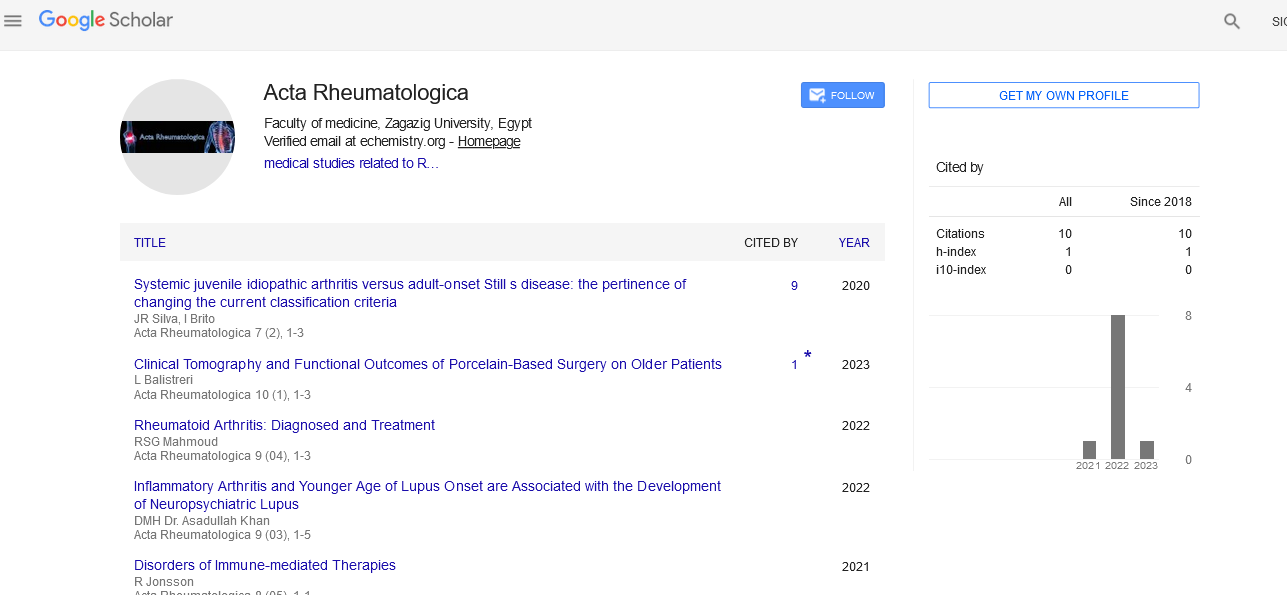Perspective - (2024) Volume 11, Issue 2
Unveiling the Complexities of Polymyalgia Rheumatica: Symptoms, Diagnosis, and Management
Magdalena Strecanska*
Department of Health Care, New York Medical College, New York, USA
*Correspondence:
Magdalena Strecanska, Department of Health Care, New York Medical College, New York,
USA,
Email:
Received: 18-Mar-2024, Manuscript No. IPAR-24-14677;
Editor assigned: 21-Mar-2024, Pre QC No. IPAR-24-14677 (PQ);
Reviewed: 05-Apr-2024, QC No. IPAR-24-14677;
Revised: 15-Apr-2024, Manuscript No. IPAR-24-14677 (R);
Published:
22-Apr-2024
Introduction
Polymyalgia Rheumatica (PMR) is a chronic inflammatory
condition that primarily affects older adults, typically those over
the age of 50. This autoimmune disorder is characterized by
widespread pain and stiffness, particularly in the shoulders,
neck, hips, and thighs. PMR can significantly impact a person's
quality of life, causing discomfort and limitations in mobility. The
exact cause of PMR remains unknown, but genetic
predisposition and environmental factors are believed to play a
role in its development.
Description
One of the hallmark symptoms of PMR is morning stiffness,
which can be severe and last for several hours. This stiffness
often affects both sides of the body symmetrically and may
gradually improve throughout the day. Alongside stiffness,
individuals with PMR may experience muscle pain, weakness,
fatigue, and a general feeling of malaise. These symptoms can
be debilitating, making everyday tasks such as getting dressed or
climbing stairs challenging.
Diagnosing PMR can be complex, as its symptoms overlap
with those of other conditions, such as rheumatoid arthritis and
fibromyalgia. Healthcare providers typically rely on a
combination of clinical evaluation, blood tests, and imaging
studies to make a diagnosis. Blood tests may reveal elevated
levels of inflammatory markers, such as C-Reactive Protein (CRP)
and Erythrocyte Sedimentation Rate (ESR), which are indicative
of active inflammation in the body. Imaging studies, such as
ultrasound or Magnetic Resonance Imaging (MRI), may also be
used to assess for inflammation in the affected joints and
surrounding tissues.
Once diagnosed, the mainstay of treatment for PMR is
corticosteroid therapy. Corticosteroids, such as prednisone or
prednisolone, work by suppressing inflammation and alleviating
symptoms. However, long-term use of corticosteroids can lead
to adverse effects, such as osteoporosis, diabetes, and increased
susceptibility to infections. Therefore, healthcare providers often
prescribe the lowest effective dose of corticosteroids for the
shortest duration possible.
In addition to medication, lifestyle modifications can also help
manage PMR symptoms and improve overall well-being. Regular
exercise, such as walking or swimming, can help improve joint
flexibility and strength, while also reducing stiffness and pain. A
balanced diet rich in fruits, vegetables, whole grains, and lean
proteins can support overall health and may help reduce
inflammation in the body. Furthermore, getting an adequate
amount of rest and practicing stress-reduction techniques, such
as meditation or deep breathing exercises, can help manage
fatigue and improve sleep quality.
In some cases, PMR may resolve on its own within a few
years, while others may experience recurrent flare-ups requiring
ongoing treatment. It is essential for individuals with PMR to
work closely with their healthcare providers to monitor their
symptoms and adjust their treatment plan as needed.
Additionally, participating in support groups or connecting with
others who have PMR can provide valuable emotional support
and practical advice for managing the condition.
Conclusion
In conclusion, polymyalgia rheumatica is a chronic
inflammatory condition that primarily affects older adults,
causing widespread pain and stiffness in the shoulders, neck,
hips, and thighs. While PMR can be challenging to diagnose and
manage, with appropriate treatment and lifestyle modifications,
individuals with PMR can experience relief from their symptoms
and maintain a good quality of life. By working closely with
healthcare providers and adopting healthy habits, individuals
with PMR can effectively manage their condition and enjoy an
active and fulfilling life.
Citation: Strecanska M (2024) Unveiling the Complexities of Polymyalgia Rheumatica: Symptoms, Diagnosis, and Management. Acta Rheuma Vol: 11 No:2





